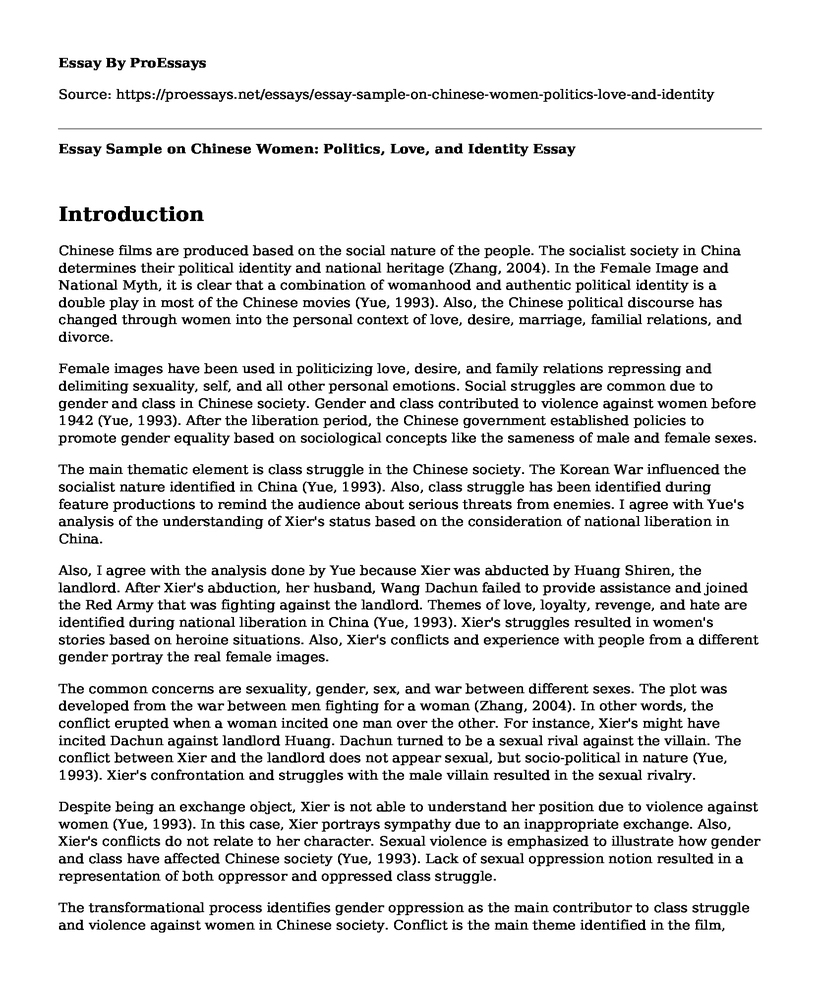Introduction
Chinese films are produced based on the social nature of the people. The socialist society in China determines their political identity and national heritage (Zhang, 2004). In the Female Image and National Myth, it is clear that a combination of womanhood and authentic political identity is a double play in most of the Chinese movies (Yue, 1993). Also, the Chinese political discourse has changed through women into the personal context of love, desire, marriage, familial relations, and divorce.
Female images have been used in politicizing love, desire, and family relations repressing and delimiting sexuality, self, and all other personal emotions. Social struggles are common due to gender and class in Chinese society. Gender and class contributed to violence against women before 1942 (Yue, 1993). After the liberation period, the Chinese government established policies to promote gender equality based on sociological concepts like the sameness of male and female sexes.
The main thematic element is class struggle in the Chinese society. The Korean War influenced the socialist nature identified in China (Yue, 1993). Also, class struggle has been identified during feature productions to remind the audience about serious threats from enemies. I agree with Yue's analysis of the understanding of Xier's status based on the consideration of national liberation in China.
Also, I agree with the analysis done by Yue because Xier was abducted by Huang Shiren, the landlord. After Xier's abduction, her husband, Wang Dachun failed to provide assistance and joined the Red Army that was fighting against the landlord. Themes of love, loyalty, revenge, and hate are identified during national liberation in China (Yue, 1993). Xier's struggles resulted in women's stories based on heroine situations. Also, Xier's conflicts and experience with people from a different gender portray the real female images.
The common concerns are sexuality, gender, sex, and war between different sexes. The plot was developed from the war between men fighting for a woman (Zhang, 2004). In other words, the conflict erupted when a woman incited one man over the other. For instance, Xier's might have incited Dachun against landlord Huang. Dachun turned to be a sexual rival against the villain. The conflict between Xier and the landlord does not appear sexual, but socio-political in nature (Yue, 1993). Xier's confrontation and struggles with the male villain resulted in the sexual rivalry.
Despite being an exchange object, Xier is not able to understand her position due to violence against women (Yue, 1993). In this case, Xier portrays sympathy due to an inappropriate exchange. Also, Xier's conflicts do not relate to her character. Sexual violence is emphasized to illustrate how gender and class have affected Chinese society (Yue, 1993). Lack of sexual oppression notion resulted in a representation of both oppressor and oppressed class struggle.
The transformational process identifies gender oppression as the main contributor to class struggle and violence against women in Chinese society. Conflict is the main theme identified in the film, Crows and Sparrows (Yue, 1993). The passage provides comprehensive information on how class struggles result in serious conflicts in society. Conflicts are common throughout the film due to differences in sexual rivalry and class struggles before national liberation. Also, conflicts in the conflict in Crows and Sparrows film may be used for entertainment (Yue, 1993).
Conclusion
To conclude, the status of women is understood from the analysis of their struggles and experiences in society. Gender-based conflicts escalate in a socialist due to differences in the levels of desires, love, sexuality, family relation, and other personal emotions. Uniformity and conformity are common factors that have dominated the socialist cinema in China.
References
Yue, M. (1993). Female images and national myths. Gender politics in modern China: Writing and feminism, 118-136. Retrieved from: https://books.google.co.ke/books?hl=en&lr=&id=UtE7qb9FRzsC&oi=fnd&pg=PA118&dq=Female+Images+and+National+Myth++Meng+Vue&ots=qqlWtk6zCI&sig=m68vCki7rZe9Uf0nGIDOUDav8lI&redir_esc=y#v=onepage&q=Female%20Images%20and%20National%20Myth%20%20Meng%20Vue&f=false
Zhang, Y. (2004). Chinese national cinema. Routledge. Retrieved from: http://ebookcentral.proquest.com/lib/uvic/detail.action?docID=199950.
Cite this page
Essay Sample on Chinese Women: Politics, Love, and Identity. (2023, Mar 27). Retrieved from https://proessays.net/essays/essay-sample-on-chinese-women-politics-love-and-identity
If you are the original author of this essay and no longer wish to have it published on the ProEssays website, please click below to request its removal:
- Racial Disparity in Incarceration
- Essay Sample on Communication Issue in a Workplace
- Research Paper on Black Lives Matter Movement
- Stevenson's Portrayal of Human Nature in the Late Victorian Society
- Annotated Bibliography on Parental Trust: A Growing Issue in Society
- Essay Example on Mayoruna Tribe: Religiousness and Way of Life
- Essay Example on the Impact of Culture on Communication: Examining Eshaad







